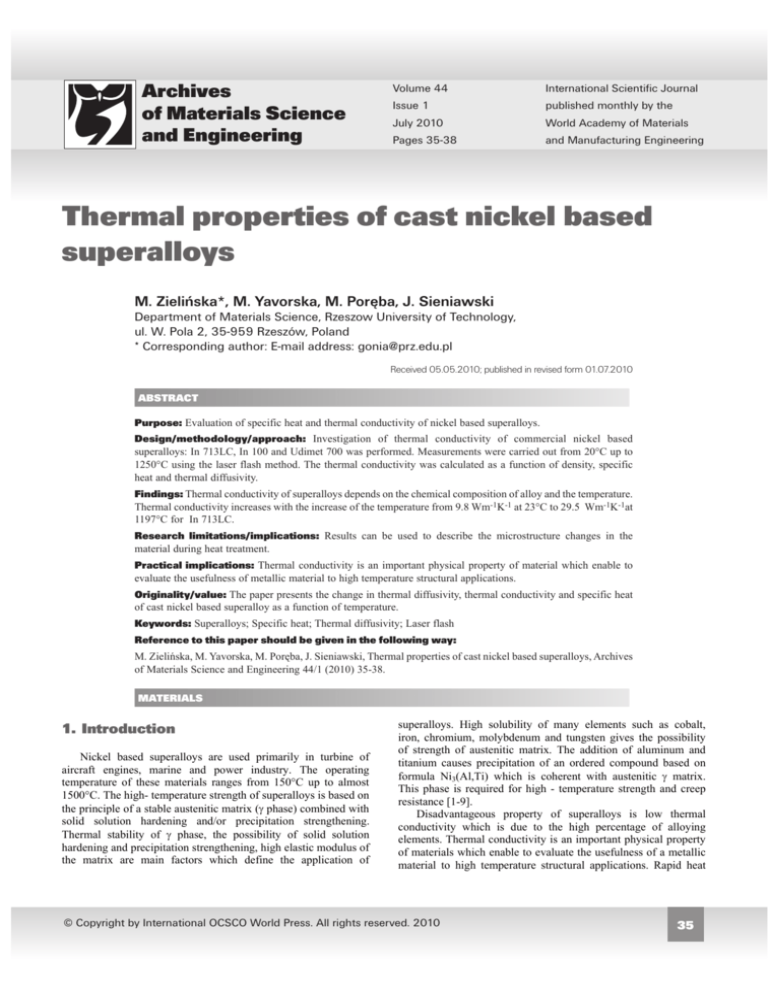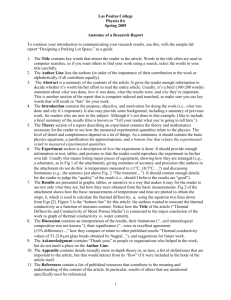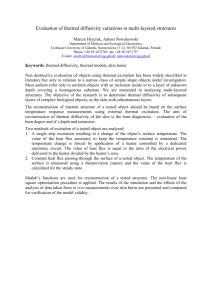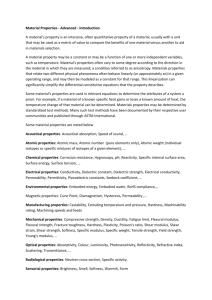
Archives
of Materials Science
and Engineering
Volume 44
International Scientific Journal
Issue 1
published monthly by the
July 2010
World Academy of Materials
Pages 35-38
and Manufacturing Engineering
Thermal properties of cast nickel based
superalloys
M. Zieliñska*, M. Yavorska, M. Porêba, J. Sieniawski
Department of Materials Science, Rzeszow University of Technology,
ul. W. Pola 2, 35-959 Rzeszów, Poland
* Corresponding author: E-mail address: gonia@prz.edu.pl
Received 05.05.2010; published in revised form 01.07.2010
ABSTRACT
Purpose: Evaluation of specific heat and thermal conductivity of nickel based superalloys.
Design/methodology/approach: Investigation of thermal conductivity of commercial nickel based
superalloys: In 713LC, In 100 and Udimet 700 was performed. Measurements were carried out from 20°C up to
1250°C using the laser flash method. The thermal conductivity was calculated as a function of density, specific
heat and thermal diffusivity.
Findings: Thermal conductivity of superalloys depends on the chemical composition of alloy and the temperature.
Thermal conductivity increases with the increase of the temperature from 9.8 Wm-1K-1 at 23°C to 29.5 Wm-1K-1at
1197°C for In 713LC.
Research limitations/implications: Results can be used to describe the microstructure changes in the
material during heat treatment.
Practical implications: Thermal conductivity is an important physical property of material which enable to
evaluate the usefulness of metallic material to high temperature structural applications.
Originality/value: The paper presents the change in thermal diffusivity, thermal conductivity and specific heat
of cast nickel based superalloy as a function of temperature.
Keywords: Superalloys; Specific heat; Thermal diffusivity; Laser flash
Reference to this paper should be given in the following way:
M. Zielińska, M. Yavorska, M. Poręba, J. Sieniawski, Thermal properties of cast nickel based superalloys, Archives
of Materials Science and Engineering 44/1 (2010) 35-38.
MATERIALS
1.
Introduction
1.Introduction
Nickel based superalloys are used primarily in turbine of
aircraft engines, marine and power industry. The operating
temperature of these materials ranges from 150°C up to almost
1500°C. The high- temperature strength of superalloys is based on
the principle of a stable austenitic matrix (J phase) combined with
solid solution hardening and/or precipitation strengthening.
Thermal stability of J phase, the possibility of solid solution
hardening and precipitation strengthening, high elastic modulus of
the matrix are main factors which define the application of
superalloys. High solubility of many elements such as cobalt,
iron, chromium, molybdenum and tungsten gives the possibility
of strength of austenitic matrix. The addition of aluminum and
titanium causes precipitation of an ordered compound based on
formula Ni3(Al,Ti) which is coherent with austenitic J matrix.
This phase is required for high - temperature strength and creep
resistance [1-9].
Disadvantageous property of superalloys is low thermal
conductivity which is due to the high percentage of alloying
elements. Thermal conductivity is an important physical property
of materials which enable to evaluate the usefulness of a metallic
material to high temperature structural applications. Rapid heat
© Copyright by International OCSCO World Press. All rights reserved. 2010
35
M. Zieliñska, M. Yavorska, M. Porêba, J. Sieniawski
transfer afforded by high thermal conductivity enables efficient
cooling which moderates the appearance of life limiting heatattacked spot. High thermal conductivity assures also a uniform
temperature distribution, which reduces thermally - induced
stresses and thereby improves fatigue properties [9-10].
The aim of the present work was to evaluate the thermal
properties of cast nickel based superalloys and the dependence of
these properties on the temperature.
2.
Experimental procedure
2. Experimental
procedure
The thermal properties of nickel based superalloys: In 713LC,
In 100 and Udimet 700, were investigated (see Table 1). The
measurements of specific heat, thermal diffusivity and roomtemperature bulk density, were performed. This data was used to
compute the thermal conductivity by the following equation:
O (T )
U c p (T ) a (T )
with:
O - thermal conductivity;
U - bulk density;
cp - specific heat;
a - thermal diffusivity;
T - temperature.
(1)
3.
Results and
3. Results
and discussion
discussion
b)
a)
c)
NETZSCH LFA 427
Fig. 1. General view of LFA 427 device: a) laser system connected
via fiber optics, b) measuring unit with furnace, a sample carrier
and In-Sb detector, c) controller for measuring unit
The thermal diffusivity was measured using a NETZSCH
model 427 laser flash diffusivity apparatus presented in Fig. 1
[11,12]. The unit used in this work was equipped with a hightemperature, water-cooled furnace capable of operation from
36
36
25 to 2000°C. The sample chamber is isolated from the graphite
heating element by a protective tube allowing samples to be
tested under vacuum or in an oxidizing, reducing or inert
atmosphere. The sample’s front surface receives a pulse of
energy from the laser. The absorbed heat travels through the
specimen thickness causing the increase of back face
temperature which is properly measured by an In-Sb detector
along the time. Data acquisition and evaluation are
accomplished by a comprehensive PC software package. The
LFA 427 operates in accordance with national and international
standards such as ASTM E-1461, DIN 30905 und DIN EN 821.
The thermal diffusivity measurements were conducted under
argon between room temperature and 1250°C. Special sample
holders with additional adapter rings were used due to different
dimensions of samples. The samples were coated with graphite
on the front and back surfaces in order to increase absorption of
the flash light on the sample’s front surface and to increase the
emissivity on the sample’s back surface. The presented thermal
diffusivity results are the average values of five individual tests.
The density of samples was measured by the buoyancy flotation
method.
The change in thermal diffusivity, thermal conductivity and
specific heat of superalloy In 713LC as a function of
temperature was measured (Fig. 2). Thermal conductivity of
In 713LC at the room temperature is 9.8 Wm-1K-1 (Table 2). The
thermophysical properties were also measured for alloys with
additional aluminide NiAl coating (Fig. 2, Table 2). NiAl is
a high thermal conducting compound of which thermal
conductivity is approximately 92.2 Wm-1K-1 [13]. The difference
in thermal conductivity at 25°C for samples with and without
layer is less than 5%. A little difference in the values of thermal
conductivities of superalloy In 713LC with and without
aluminide coating is due to the higher substrate thickness than
the coating one [12].
Similar dependencies of thermal properties were detected for
sample In100 (Fig. 3, Table 3). Thermal conductivity at the room
temperature of this alloy is 9.1 Wm-1K-1. Lower values of thermal
conductivity are the results of higher alloying elements
contamination in this superalloy (see Table 1). Slight steps were
detected in thermal diffusivity, heat capacity and thermal
conductivity for all samples above 500°C (Figs. 2, 3). Much the
same results was obtained by Przeliorz and other authors [14] who
investigated the heat capacity of superalloys by the DSC method.
They observed the increase of heat capacity above the
temperature of 500°C and then the drop up to the temperature of
700°C, on the DSC curve. This phenomena is probably due to the
distribution of J’ phase [15]. Between temperature of 700°C and
800°C the thermal conductivities remains constant and then
slightly increase (Figs. 2, 3). Lower values of thermal diffusivity
and conductivity were detected for samples of Udimet 700 which
has the highest alloying elements content (Fig. 4, Table 4).
Archives of Materials Science and Engineering
Thermal properties of cast nickel based superalloys
Table 1.
Chemical compositions of investigated alloys
Elements content, %mass
Superalloy
Ni
Cr
Co
Mo
Al
Ti
C
B
Zr
Nb
Inconel 713LC
74
12.5
-
4.2
6.1
0.8
0.05
0.012
0.1
2.0
Inconel 100
60
10
15.0
3.0
5.5
4.7
0.18
0.014
0.06
-
Udimet 700
58
14.6
15.0
4.2
4.3
3.3
0.07
0.016
0.04
-
Diffusivity
Diffusivity
ThermalConductivity
Thermal
SpecificHeat conductivity
Specific heat
with layer
with layer
88
7
Sample: In 100
Density (25°C): 7.910 g/cmá
Thickness: 4.300 mm
50
50
Thermal Conductivity / W/(m*K)
Thermal
conductivity, W/(m·K)
Thermal diffusivity, mm2/s
9
40
40
2
30
30
1.5
20
20
1
66
5
44
3
22
10
10
1
00
33
60
60
Specific heat,
Heat / J/(g*K)
Specific
J/(g·K)
10
10
00
200
200
400
400
600
600 800
800
Temperature / °C
Temperature, ºC
1000
1000
1200
1200
00
0
Fig. 2. Thermal diffusivity, thermal conductivity and specific heat
of superalloy In 713LC as a function of temperature
60
60
Diffusivity
Diffusivity
ThermalConductivity
Thermal
SpecificHeat conductivity
Specific heat
88
Sample: In 100
Density (25°C): 7.910 g/cmá
Thickness: 4.300 mm
7
40
40
2
30
30
1.5
20
20
1
66
5
44
3
22
10
10
1
00
3
3
50
50
Thermal Conductivity / W/(m*K)
Thermal
conductivity, W/(m·K)
Thermal diffusivity, mm2/s
9
Specific heat,
Heat / J/(g*K)
Specific
J/(g·K)
10
10
00
200
200
400
400
600
600 800
800
Temperature / °C
Temperature, ºC
1000
1000
1200
1200
0
00
Fig. 3. Thermal diffusivity, thermal conductivity and specific heat
of superalloy In 100 as a function of temperature
Volume 44
Issue 1 July 2010
Table 2.
Thermal diffusivity, thermal conductivity and specific heat of
superalloy In 713LC as a function of temperature
Superalloy: In 713C - density: 7.950 g/cm³
Thermal
Thermal
Temperature,
Specific
diffusivity,
conductivity,
°C
heat, J/(g·K)
mm²/s
W/(m·K)
2.783
9.823
24
(with layer:
0.444
(with layer:
2.929)
10.288)
101
3.129
0.467
11.617
199
3.420
0.489
13.295
300
3.695
0.503
14.776
400
4.017
0.517
16.510
500
4.337
0.528
18.205
601
4.606
0.590
21.604
701
4.887
0.592
23.000
800
4.877
0.606
23.496
900
4.995
0.615
24.422
997
5.157
0.637
26.116
1097
5.351
0.662
28.162
1197
5.564
0.668
29.548
Table 3.
Thermal diffusivity, thermal conductivity and specific heat of
superalloy In 100 as a function of temperature
Superalloy: In 100 - density: 7.910 g/cm³
Temperature,
°C
18
98
199
299
401
500
599
701
799
898
998
1097
1197
Thermal
diffusivity,
mm²/s
2.613
2.891
3.154
3.410
3.729
3.977
4.269
4.637
4.649
4.738
4.932
5.045
5.232
Specific heat
J/(g·K)
0.440
0.467
0.489
0.503
0.517
0.528
0.588
0.592
0.606
0.615
0.637
0.662
0.668
Thermal
conductivity,
W/(m·K)
9.094
10.679
12.200
13.567
15.250
16.610
19.855
21.714
22.285
23.049
24.851
26.418
27.645
37
60
60
Specific heat
7
50
50
40
40
66
30
30
5
44
20
20
3
22
10
10
[1]
2
Specific Heat / J/(g*K)
Specific
heat, J/(g·K)
8
References
References
33
Thermal Conductivity / W/(m*K)
2
Thermal
diffusivity,
Thermal Diffusivity
/ mm˛/smm /s
9
Sample: Udimet 700
Diffusivity
Density (25°C): 7.988 g/cmá
Thermal conductivityThickness: 3.650 mm
Diffusivity
ThermalConductivity
SpecificHeat
Thermal conductivity, W/(m·K)
10
10
1.5
1
[2]
[3]
[4]
1
00
700
700
800
800
900
1000
1100
900
1000
1100
Temperature / °C
Temperature,
ºC
0
1200
1300
1200
1300
00
Fig. 4. Thermal diffusivity, thermal conductivity and specific heat
of superalloy Udimet 700 as a function of temperature
Table 4.
Thermal diffusivity, thermal conductivity and specific heat of
superalloy In 100 as a function of temperature
Superalloy Udimet 700 - density: 7.988 g/cm³
Thermal
Thermal
Temperature,
Specific heat,
diffusivity,
conductivity,
°C
J/(g·K)
mm²/s
W/(m·K)
760
4.232
0.601
20.317
872
4.200
0.610
20.465
980
4.283
0.633
21.657
1090
4.610
0.660
24.304
1178
4.638
0.668
24.748
1248
4.415
0.668
23.558
4.
Conclusions
4. Conclusions
Thermal conductivity of superalloys depends on the chemical
composition of alloy and the temperature. It was confirmed that
alloying elements decrease the thermal conductivity of
superalloys. Thermal conductivity increases with the increase of
the temperature from 9.8 Wm-1K-1 at 23°C to 29.5 Wm-1K-1 at
1197°C for alloy Inconel 713LC, 9.0 Wm-1K-1 at 19°C to 27.6
Wm-1K-1 at 1197°C for Inconel 100 and 20.3 Wm-1K-1 at 760°C to
23.6 Wm-1K-1 at 1248°C for Udimet 700. Slight steps were
detected in thermal diffusivity and conductivity for samples above
500°C which is probably due to the distributing of J’ phase.
Acknowledgements
Acknowledgements
This work has been financed by the Ministry of Science and
Higher Education in framework of the PBZ-MNiSW1/1/2007
research project.
38
38
[5]
[6]
[7]
[8]
[9]
[10]
[11]
[12]
[13]
[14]
[15]
J. Sieniawski, Nickel and titanium alloys in aircraft turbine
engines, Advances in Manufacturing Science and
Technology 27/3 (2003) 23-34.
J.R. Davis, Heat-Resistant Materials, ASM Speciality
Handbook, ASM International, 1999.
M. ZieliĔska, J. Sieniawski, M. PorĊba, Microstructure and
mechanical properties of high temperature creep resisting
superalloy René 77 modified CoAl2O4, Archives of
Materials Science and Engineering 28/10 (2007) 629-632.
M. ZieliĔska, K. Kubiak, J. Sieniawski, Surface modification,
microstructure and mechanical properties of investment cast
superalloy, Journal of Achievements in Materials and
Manufacturing Engineering 35/1 (2009) 55-62.
P. Baáa, New tool materials based on Ni alloys
strengthened by intermetallic compounds with a high
carbon content, Archives of Materials Science and
Engineering 42/1 (2010) 5-12.
A. Onyszko, K. Kubiak, Method for production of single
crystal superalloys turbine blades, Archives of Metallurgy
and Materials 54/3 (2009) 765-771.
R.C. Read, The Superalloys Fundamentals and Application,
Cambridge University Press, Cambridge, 2006.
H. HetmaĔczyk, L. SwadĨba, B. Mendala, Advances
materials and protective coatings in aero-engines
application, Journal of Achievements in Materials and
Manufacturing Engineering 24/1 (2007) 372-381.
J.H. Suwaride, R. Artiaga, J.L. Mier, Thermal
characterization of a Ni-based superalloy, Thermochimica
Acta 392-393 (2002) 295-298.
Y. Terada, K. Ohkubo, S. Miura, J.M. Sanchez, T. Mohri,
Thermal conductivity and thermal expansion of Ir3X
(X=Ti, Zr, Hf, V, Nb, Ta) compounds for high temperature
applications, Materials Chemistry and Physics 80 (2003)
385-390.
S. Min, J. Blumm, A. Lindemann, A new laser flash
system for measurement of the thermophysical properties,
Thermochimica Acta 455 (2007) 46-49.
O. Altun, Y. Erhan Boke, A. Kalemtas, Problems for
determining the thermal conductivity of TBCs by laser
flash method, Journal of Achievements in Materials and
Manufacturing Engineering 30/2 (2008) 115-120.
Y. Terada, K. Ohkubo, T. Mohri, T. Suzuki, Effects of
ternary additions on thermal conductivity of NiAl,
Intermetallics 7 (1999) 717-723.
R. Przeliorz, L. SwadĨba, M. Góral, Heat capacity versus
heat resistance of the casting nickel superalloys intended
for turbine blades, Corrosion Protection 51/4-5 (2008)
171-173 (in Polish).
S.H. Lee, S.W. Kim, K.H. Kang, Effect of heat treatment on
the specific heat capacity of nickel based-alloys, International
Journal of Thermophysics 27/1 (2006) 282-293.
READING DIRECT: www.archivesmse.org








